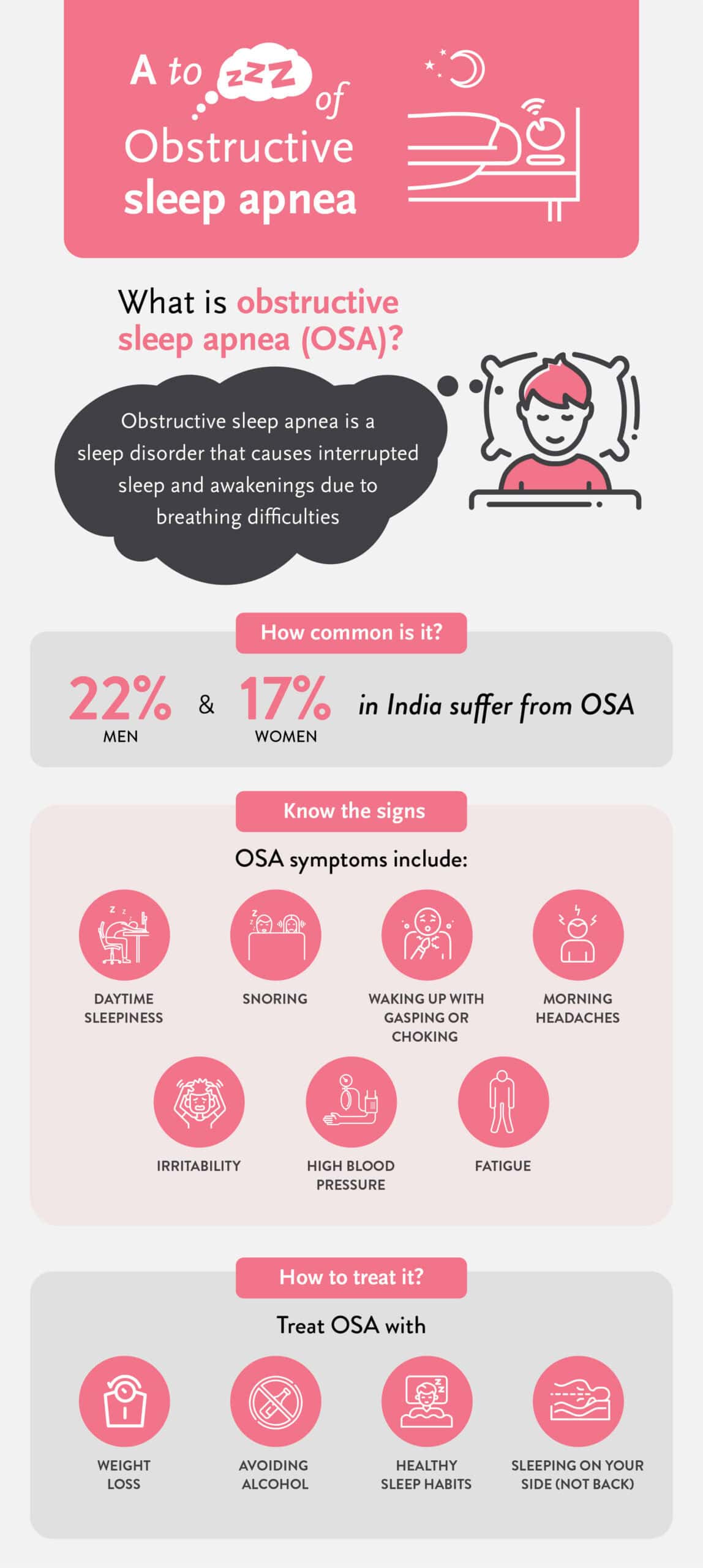Everything You Need to Know About Obstructive Sleep Apnea
Does your partner often complain about your snoring? Do you wake up tired after a full night’s sleep? Do you experience interrupted sleep and feel sleepy during the day? If so, then this article is for you. Disrupted sleep, snoring, difficulty in breathing and poor sleep quality are some attributes of a common sleep disorder – obstructive sleep apnea (OSA). According to a study, nearly 22% of men and 17% of women in India suffer from OSA. This condition is more prevalent in men compared to women.
In this article, with insights from Dr Kuldeep Kumar Grover, a leading pulmonologist at the CK Birla Hospital, we will explore everything you need to know about obstructive sleep apnea.
Table of Contents
What is obstructive sleep apnea?
Obstructive sleep apnea (OSA) is one of the most common sleep-related disorders. It is a type of sleep apnea.
Sleep apnea is a condition in which a person experiences interrupted sleep due to breathing difficulties. It causes you to stop and start breathing at varying intervals several times in your sleep.
There are mainly two types of sleep apnea:
- Obstructive sleep apnea – This disorder occurs as a result of complete or partial blockage of the upper airways. It happens when your throat muscles relax and block your airways at irregular intervals during your sleep.
- Central sleep apnea – In central sleep apnea, there is no airway blockage. It happens when your brain fails to send signals to your muscles to breathe.

What are the obstructive sleep apnea symptoms?
The signs and symptoms of OSA affect every individual differently. Common obstructive sleep apnea symptoms include:
- Increased sleepiness during daytime
- Loud snoring
- Episodes of stopped breathing during sleep
- Sudden and abrupt awakenings in the night along with a feeling of gasping or choking
- Waking up in the night with a dry mouth or sore throat
- Headaches in the morning
- Problems in concentration during the day
- Mood swings including depression or irritability
- High blood pressure
- Decreased sexual drive
Some of the above-given symptoms overlap with symptoms of other, underlying medical conditions. For instance, loud snoring is not necessarily an indicator of OSA. Your healthcare provider will be better able to overcome these diagnosis dilemmas and provide a comprehensive outlook and understanding of your condition.
Obstructive sleep apnea symptoms can be life-threatening if not addressed in a timely manner.
Obstructive sleep apnea in children is different from that in adults. OSA symptoms in children may be as obvious. Common symptoms include:
- Bedwetting
- Choking or drooling
- Excess sweating a lot at night
- Learning, behaviour and developmental problems
- Difficulty in learning lessons or socialising at school
- Sleepiness
- Snoring
- Teeth grinding
- Restlessness in bed
What are the obstructive sleep apnea causes?
The muscles in the back of your throat offer support to the structures in your mouth including your soft palate, uvula, tonsils and tongue. Obstructive sleep apnea causes when these muscles relax more than what is required for normal breathing.
In this condition, your throat muscles relax making your airways more narrow or close during breathing. Due to this narrowing of airways, you experience a disruption in breathing for longer than 10 seconds. Disrupted breathing, in turn, can cause a drop in the oxygen levels in your blood and a build-up of carbon dioxide.
When breathing is hampered and your oxygen levels dip, your brain signals you to reopen your airways to continue breathing normally. Most of the time, this awakening signalled by the brain is so short that you do not usually remember it.
However, in this condition, you are likely to experience such short awakenings due to breathing difficulty nearly 5-30 times or more each hour. This leads to a highly disturbed, disrupted sleep.
Who gets obstructive sleep apnea?
While obstructive sleep apnea causes can affect anyone at any age, some people are more vulnerable to developing it than others.
You have a higher chance of experiencing OSA if you experience the following:
Obesity: Overweight or obese people are more likely to suffer from sleep apnea. It is because extra fat deposits around the upper airways can cause breathing difficulties easily.
Advanced age: Your risk of OSA grows as you advance in age. People who are older than 60 years of age are more likely to be affected by this condition.
Genetic factors: A family history of sleep apnea can make you more susceptible to this disease. It is also because of the inheritance factor of naturally narrowed airways.
Underlying health problems: OSA is more common in people who live with underlying medical problems such as hypertension, asthma and diabetes.
Chronic nasal congestion: If you live with chronic nasal congestion, you will have a greater problem breathing during sleep.
Smoking: Smoking cigarettes affect your respiratory health making you more vulnerable to OSA.
How is obstructive sleep apnea detected?
Usually, obstructive sleep apnea is detected when an individual presents with the above-given symptoms and complaints. Your healthcare provider will take your complete personal and family history of the disease, present-day symptoms and evaluate your overall health.
He/she may further recommend certain tests to diagnose the condition properly such as polysomnography and home sleep apnea test.
What is obstructive sleep apnea treatment?
Obstructive sleep apnea treatment is based on factors including your unique symptoms, underlying health conditions and age.
Listed below are some common obstructive sleep apnea treatment methods:
Lifestyle changes
Based on your lifestyle choices and general health, your healthcare provider will recommend making the following modifications:
- Lose weight if obese
- Avoid or quit smoking
- Exercise regularly to maintain a healthy weight
- Don’t sleep on your back
- Using medicines or inhalers for nasal congestion
- Avoid consumption of alcohol
Use of mouthpiece or positive airway pressure
Positive airway pressure is a therapy that helps in reducing the number of respiratory events. While an oral device such as a mouthpiece is an appliance designed to improve your sleep quality by keeping your throat open and relieving OSA.
Surgery
Obstructive sleep apnea can be treated with surgical interventions including the removal of tissues from the back of your throat, upper airway stimulation and jaw surgery.
If you are suffering from mild obstructive sleep apnea symptoms, you can take the following measures for relief:
- Sleep on your side
- Lose weight
- Exercise everyday
- Avoid smoking or drinking
- Treat nasal congestion
What are the complications of OSA?
If obstructive sleep apnea is not treated properly and timely, it can have serious complications. Untreated OSA can result in:
Daytime sleepiness & fatigue: Obstructive sleep apnea can negatively impact your sleeping habits and health making it difficult for you to have a proper, sound and restful sleep. A lack of full sleep can leave you drained and fatigued.
Cardiovascular problems – Narrowed upper airways can lead to a decrease in oxygen levels in your blood. This drop directly impacts your heart health and leads to a range of cardiovascular problems including abnormal heart rhythms, coronary artery disease, heart attacks, heart failure and strokes.
Medicinal and surgical complications – Certain medications and general anaesthesia used for surgical procedures can further narrow your upper airway making it more difficult to breathe properly during sleep.
Eye problems – Studies have found that obstructive sleep apnea can result in an increased risk of developing eye complications such as glaucoma.
Problems in your relationships – Troubling symptoms of OSA such as loud snoring can also put a strain on your relationship with your partner as such symptoms may also affect their sleep.
Other problems caused by untreated OSA include:
- Memory problems
- Morning headaches
- Depression
- Increased need to urinate at night
The concluding note
Obstructive sleep apnea (OSA) is a highly prevalent condition, especially among Indian men. It can, however, be effectively treated if you receive medicinal intervention and guidance before the condition progresses.
Your treatment is entirely dependent on your unique health markers, symptoms and lifestyle. It is, thus, important to consult a healthcare provider who can help you in understanding your risk and guide you to live a better, healthier lifestyle in order to improve your quality of sleep and quality of life.
Learn about your risk of obstructive sleep apnea through a one-on-one consultation with Dr Kuldeep Kumar Grover, a leading pulmonologist in Gurgaon.




